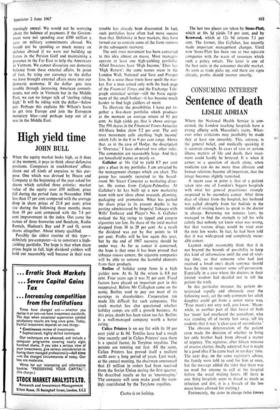High yield time
JOHN BULL
When the equity market looks high, as it does at the moment, it pays to think about defensive positions. Computers in stockbrokers' offices churn out all kinds of exercises to this pur- pose. One which was devised by Hoare and Company at the beginning of the year asked for shares which satisfied three criteria: market value of the equity over f50 million; price fall during the period June to November 1966 less than 17 per cent compared with the average drop in share prices of 21.6 per cent; price rise during the following three months more than 10 per cent compared with the 7.4 per cent improvement in the index. Out came the names of three breweries and Beecham, Radio Rentals, Hudson's Bay and P and 0, seven shares altogether. About ninety qualified.
Possibly the oldest routine of this type— definitely pre-computer—is to construct a high- yielding portfolio. The hope is that when share prices begin to fall, high dividend yielders will hold out reasonably well because in their case
trouble has already been discounted. In fact, such portfolios have often had more success than that. Defensive in bear markets, they have turned out to contain some of the front runners
in the subsequent recovery.
The unit trust movement has been converted to this idea almost en masse. Most managers operate at least one high-yielding portfolio.
Allied Investors have `High Income,' Ebor has `High Return'; the same names recur in the
London Wall, National and Save and Prosper lists. In a sense these trusts have spoilt the mar- ket. For a man armed only with the back page
of the Financial Times and the Exchange Tele- graph statistical service—still the basic equip- ment of the small broker—it has become much harder to find high yielders of merit.
To illustrate the possibilities I have put to- gether a five-share portfolio which produces at the moment an average return of 84- per
cent. As high yields go, that is above average. The 594 shares in the Financial Times-Actuaries
All-Share Index show 5.2 per cent. The unit trust movement calls anything `high income' which falls in the 6 to 9 per cent range. Above that, as in the case of Hodge, the description is 'Overseas.' I have observed two other rules. The companies are reasonably large. And they are household names or nearly so.
Gallaher at 16s lid to yield 8.7 per cent gets a place in my portfolio. I am attracted by the management changes which are afoot. The group has recently recruited to the board- room Mr Stuart Cameron as marketing direc- tor. He comes from Colgate-Palmolive. At Gallaher's he has built up a new marketing team with new ideas about research, planning, packaging and promotion. What has pushed the share price to its present depths is the pasting administered by Imperial Tobacco with Wills' Embassy and Player's No. 6. Gallaher noticed the big swing to tipped and coupon cigarettes too late. Its share of the total market dropped from 36 to 28 per cent. As a result the dividend was cut by five points to 14 per cent. Profits will be -low again this year, but by the end of 1967 recovery should be under way. As far as cancer is concerned, the hope is that once it has been proved that
tobacco causes cancer, the cigarette companies will be able to remove the harmful elements from their products.
Butlins of holiday camp fame is a high yielder now. At 6s 3d the return is 8.8 per cent. Four years ago it was 3+ per cent. Fiscal factors have played an important part in this reappraisal. Before Mr Callaghan came on the scene, Butlins used to pay out most of its earnings to shareholders. Corporation tax made life difficult for such companies. The stock market has also questioned whether holiday camps are still a growth business. At this price, doubt has been taken too far. Butlins is a well-managed company worth a better rating.
Calico Printers is on my list with its 10 per cent yield at gs Od. Textiles have had a rough time recently and in Calico Printers' case there is a special factor, its Terylene royalties. The patents are running out fast. All the same, Calico Printers has proved itself a resilient outfit over a long period of years. Last week, at the annual meeting, the chairman announced that £1 million in orders had been received from the Soviet Union during the first quarter. He described results so far as 'encouraging' The company will soon make good the earn- ings contributed by the Terylene royalties.
Custos is on holiday. The last two places are taken by Stone-Platt, which at lOs 3d yields 7.8 per cent, and by Kenwood, which at 12s 9d returns 7.1 per cent. The former, like Gillaher, has recently made important management changes. Until now Stone-Platt has been run as two separate companies with the waste of resources which such a policy entails. The latter is one of the best units in the consumer durable market. As soon as trade picks up, and there are signs already, profits should recover smartly.


































 Previous page
Previous page